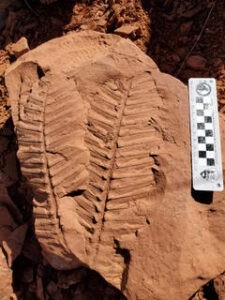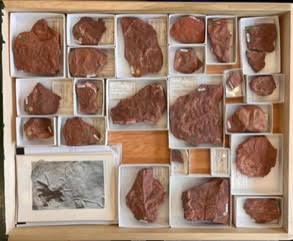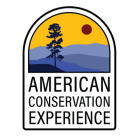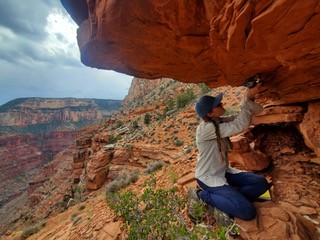Paleontology in the Grand Canyon
Written by: Mikaela Pulsipher
I was in the middle of a Ph.D. at the University of Missouri when I heard about an open ACE-EPIC paleontology position at Grand Canyon National Park. It was a dream position, to be honest. Significant field work component? Being in the field is what I love most about the geosciences. Grand Canyon National Park? I love the Grand Canyon; I’d already spent quite a bit of time there on the river and backpacking. Working with the NPS geoscience team? What a perfect trial run for a potential future career with a federal agency. How could I not apply? So, I did, and one month later I finalized a leave of absence from Mizzou, moved 1,200 miles away, and started learning about the Permian Period and paleobotany, subjects with which I had zero experience.
 In January I was fortunate to spend a week in the collections of the Smithsonian National Museum of Natural History, and the kid in me who has always loved museums and planetariums was elated to be behind the scenes of one of the most famous museums in the world. My primary focus is the paleontology and depositional environment of the Permian Hermit Formation, an incredible paleontological resource in Grand Canyon National Park that hosts remarkable plant fossils, vertebrate footprints, and even fossilized insect wings! Despite its paleontological splendor, the Hermit Fm. hasn’t been the focus of a scientific study since 1929, when Dr. David White published a monograph detailing a suite of fossils collected in the park. White’s collections were accessioned at the Smithsonian, and I was there to see those specimens. The photographs in White’s monograph are not the best quality (although I’m sure they were great for the 1920’s), and I needed new photos so I can better evaluate the preservation and morphological variation of some of the species. Community understanding of Permian paleobotany has come a long way in the last century, and White’s work is due for some updates and reinterpretation.
In January I was fortunate to spend a week in the collections of the Smithsonian National Museum of Natural History, and the kid in me who has always loved museums and planetariums was elated to be behind the scenes of one of the most famous museums in the world. My primary focus is the paleontology and depositional environment of the Permian Hermit Formation, an incredible paleontological resource in Grand Canyon National Park that hosts remarkable plant fossils, vertebrate footprints, and even fossilized insect wings! Despite its paleontological splendor, the Hermit Fm. hasn’t been the focus of a scientific study since 1929, when Dr. David White published a monograph detailing a suite of fossils collected in the park. White’s collections were accessioned at the Smithsonian, and I was there to see those specimens. The photographs in White’s monograph are not the best quality (although I’m sure they were great for the 1920’s), and I needed new photos so I can better evaluate the preservation and morphological variation of some of the species. Community understanding of Permian paleobotany has come a long way in the last century, and White’s work is due for some updates and reinterpretation.
 These past few months at Grand Canyon have been an awesome experience; I’m really valuing the break from academia and the opportunity to try something new. Imposter syndrome and I are close acquaintances, it’s hard to avoid when you’re in grad school, and I’ve spent a lot of time worrying that I don’t actually know what I’m doing. Getting to plan the field work I want to accomplish, choose target sites, determine sampling strategies, and use field skills that I feel adept at has been great for my overall confidence and self-assuredness. There are still stumbling blocks, and there’s a lot that I don’t know, but I’m learning so much and gaining so many new skills and having a great time doing it. My biggest takeaway so far? Just go for it; apply for that position you’re interested in, reach out to that person you want to work with, do that thing you think might make you happier even if you’re scared. It really could work out for you.
These past few months at Grand Canyon have been an awesome experience; I’m really valuing the break from academia and the opportunity to try something new. Imposter syndrome and I are close acquaintances, it’s hard to avoid when you’re in grad school, and I’ve spent a lot of time worrying that I don’t actually know what I’m doing. Getting to plan the field work I want to accomplish, choose target sites, determine sampling strategies, and use field skills that I feel adept at has been great for my overall confidence and self-assuredness. There are still stumbling blocks, and there’s a lot that I don’t know, but I’m learning so much and gaining so many new skills and having a great time doing it. My biggest takeaway so far? Just go for it; apply for that position you’re interested in, reach out to that person you want to work with, do that thing you think might make you happier even if you’re scared. It really could work out for you.

